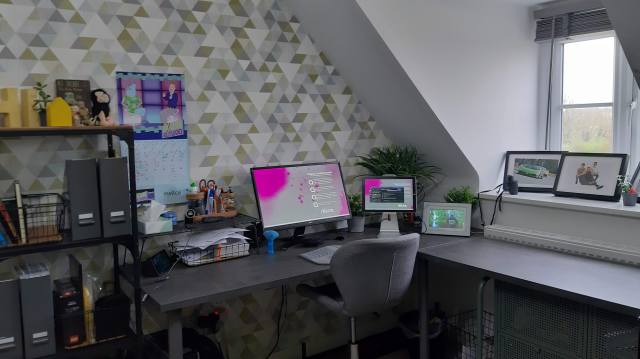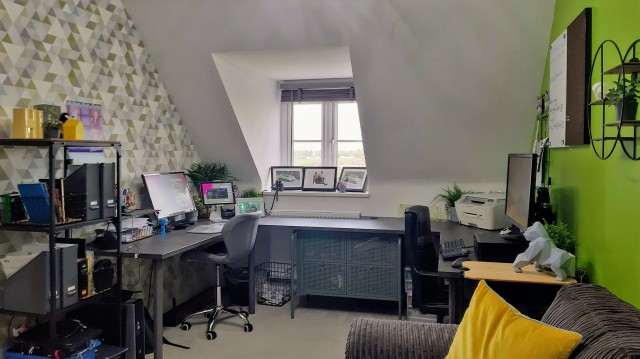My current job as an Enterprise Architect for risual has my place of work officially listed as my home, although I’m regularly out visiting clients. I share that home with my wife, 3 sons and a cat (the cat is the only one with me in the daytime). As a relative newcomer to the home-working scene, I thought it would be interesting to share my experience over the last year in how I’ve adjusted to this new way of working. I was inspired by one of Scott Hanselman’s tweets around going for a morning commute even if you work from home:
Now, I’m sure most home-workers will tell you one of the best perks of being based at home is avoiding the traffic-filled commute but something about Scott’s tweet definitely rings true. It made me think of what I’ve done to motivate me to get out of bed in the morning when I could just as easily roll out at 8:55. How do you get into good habits rather than develop bad habits? So here are my personal 6 rituals of working from home.
Ritual 1 – Rise and shine
Those first few weeks I took full advantage of being able to have a lie-in. My wife and kids leaving the house before I had even woken up gave me a certain schadenfreude that let me fool myself it was something I could maintain. What actually ended up happening was me having a poor quality of sleep because of all the noise of everyone else in the house. This led to annoying thoughts/dreams about work of all things, but what I hadn’t expected was that it actually gets a bit depressing. Jumping straight out of bed and then being on a laptop 5 minutes later is actually pretty soul-crushing. What I found is that it is actually a lot better to get up earlier, maybe an hour or so, so you can actually see the family, have a proper breakfast and get a few minutes fresh air. I’m not saying that’s easy to do. Each person will have their own motivation, like going to the gym, walking the dog, reading, podcasts, getting a coffee from a local shop etc. For me, I used Netflix to get me in the routine of getting up with enough time to properly wake up. Instead of staying up late watching TV, I got up just early enough so I could watch a 25-minute comedy every morning. This played into my laziness but also, as I got more into the show, I started to look forward to waking up. It helps to pick something that has a lot of episodes! I started with Schitt’s Creek (on my wife’s recommendation) and now moved on to Archer (one of my brother’s favourites) but I’d also highly recommend Bojack Horseman, Arrested Development or The Office (UK & US).
Ritual 2 – A workspace you can be proud of
This is a very common tip I’ve seen from most people but it just makes so much sense. No-one wants to work for 8 or more hours a day in a cramped space or somewhere that gets constant interruptions. If you are going to be working at home for a while, try to carve out a space for yourself that you can make your own. I was very lucky that we had a spare room available. It started out as a bedroom with a desk to become an office with a sofa bed. It’s what we jokingly call our Shared Workspace Meetup Hangout and there is enough space for 3 of us to work from even though it’s only me in there 99% of the time (the cat is banned!). It started out with a DSE Self Assessment form. This was actually a mandatory requirement of the condition of me starting at risual, much the same as if I was in an office I’d expect the employer to provide the correct environment for me to work safely. It was very simple to do and made me think about my health and how I could be comfortable throughout the day. So I bought a good chair, got a monitor that was the right size, and got a riser for my Surface so I could use that comfortably as a second screen. Once the essentials were taken care of I then got to have a bit of fun making the room exactly as I wanted – cool furniture, funky wallpaper, lots of fake leafy green plants (and a couple of real ones) and a place to crash when I wanted a break. This turned out being our sofa bed and I set up a spare TV and old Xbox, my excuse being that it makes it nice for any guests staying over. I haven’t actually turned it on once since I’ve set it all up but there’s something relaxing just knowing it’s there!

My space (and gadgets!) 
Room with a view
I also got a few tech upgrades to make the environment more practical for permanent use:
- A “hockey-puck” speakerphone – talking out loud in a room seems to help me psychologically feel like I’m part of the conversation rather than on a headset.
- A decent HD webcam – I love my old Surface 3 but the webcam quality leaves a lot to be desired. I had an 8-year-old “Tandberg HD” desktop webcam that still works great, has autofocus and lets me place it wherever I want in the room to get the best light.
- Whiteboard – A physical one on the wall so I can draw out ideas when I’m planning things or have an in-your-face reminder. I prefer to use the more collaborative Whiteboard app in Microsoft Teams during meetings but in theory, I could show my physical one if the other side of the call can’t access the app.
- Ergonomic Keyboard – I’ve always liked these but it’s rare you see them in an office. I went for the Microsoft Surface version and it’s great. I’ve never experienced any wrist pain even when I’ve spent all day typing up a strategy document.
- Mesh Wi-fi – This lets you position little wi-fi repeaters around your house so you get a good strong signal whatever room you are in. I found a set of 3 for under £150 that work great.
- A paper monthly calendar – OK, so this is quite low-fi but I had the wall space and it’s great to have a permanent visual aid to make a quick note of where I’ll be.
- Binoculars – This is a funny one but my office is in the attic and I have a good view out of the window. I got these as a present and it’s very relaxing to just have a look out the window every now and again!
Ritual 3 – Get on with it
I’ve always struggled with procrastination and working at home is even more of an excuse to get distracted. The first two rituals help with this but it made me realise that when I was in an office I would actually procrastinate quite a lot before getting started; chatting to colleagues, reading Twitter, then emails and chat messages, then maybe doing some more fun stuff before getting to the real day’s work. Well, unfortunately, that urge to do anything else rather than what I really should be doing seemed more amplified when I was on my own. However, it also conflicts with presenteeism – the feeling that you need to make it known that you’re busy all the time; the paranoia that people will think you are slacking off because they can’t physically see you at your desk. I think that is a big part of “homeworkers guilt” (more on that in the ritual below) but I find the only way around it is to just “get on with it”. Get your to-do list for the day and start with the priorities first. Priorities may change as the day goes on but if anyone did ask what you were up to (not that I ever think anyone would, certainly where I work), then you’ve at least got some justification for what you are doing that day. Also, if you at least get started on what you need to do, then it makes it easier to get back to if something does interrupt you.
Ritual 4 – It’s OK to take a break
I mentioned “homeworkers guilt” above and this is something that I think takes real practice to actually stop that nagging voice in the back of your head. I heard a stat that something like 90% of home-based workers do up to 10 hours a week more work than their office-based equivalent but that didn’t really re-assure me. Partly because I think it’s more individual than a generic stat can portray, but also working from home is so different from being in an office that they aren’t really comparable. So, for me, I had to repeat the mantra in my head “It’s OK to take a break, it’s OK to take a break, it’s OK to take a break” every time I went to boil the kettle, answer the door or even go to the toilet! This took me a lot of time to get over, even though I knew it was all in my head. Talking to my more experienced colleagues helped re-assure me and at the end of the day, my work is judged on the output I give rather than me being chained to a keyboard. One of the things that helped was to remember what an office environment is really like; people take breaks whenever they want. Maybe the reason there isn’t that guilt there is because they say to their nearby colleagues that they are actually having a break, or it’s obvious if someone stands up and goes off for a while. Not having those visual cues when you are alone can make you feel like you need to be available all the time. So a tip is to just set your IM status to “BRB” or “Out to lunch”. In theory, it will probably switch to “away” when your screen is locked but consciously doing it is much like standing up from your desk in an office. Since doing that, I feel much more comfortable taking my time to brew a proper coffee, make a personal phone call or unload the dishwasher. As well as short breaks, the same goes for lunchtimes. I found myself working through lunch to get more done but then still ended up working late anyway after getting into the flow of things. That didn’t do my mental, or physical, health any good. Now I make sure I have an hour in my calendar for lunchtime. Sure, things move around and it doesn’t always go to plan, but even if I just take the time to make myself a proper meal and sit down away from a screen then I feel so much more refreshed and re-energised to get on with my afternoon’s work. I like to make a proper fuss of my food where even a basic cheese sandwich becomes something the most artisanal hipster café could be proud of ?.

Ritual 5 – Don’t let alone mean lonely
All the other rituals are more about how you can help yourself work alone, but a big part of working alone is being with other people! Make full use of whatever tools you have to be a good colleague.
- Use your IM presence indicator and respect other peoples’ status.
- If people aren’t busy, say hello!
- Take part in the group chats/forums while you’re having that break.
- Use video when you can, especially for the start of a meeting (this is a tricky one depending on work culture but I keep trying it!)
- Arrange or take part in work social events and real-life get-togethers
The same applies to your social networks too. You need to make the effort to speak to others, interact on twitter, share on LinkedIn or post odd photos on Instagram. I use the app/service called Meetup to find user groups that I can go to, either locally or when I’m out overnight at a client site. They are all over the country and cover a massive range of topics. Some of the most interesting meetups I’ve been to aren’t necessarily ones about subjects I deal with day to day but I’ve just gone along because the alternative was sitting in a hotel room.
Ritual 6 – Turn off, tune out
This one is short and sweet. It’s unlikely there will be a time when you’ve 100% completed everything you need to. When you feel like you’ve done a good day’s work then turn off that laptop and walk away from it. Although I have work apps on my personal phone, both Outlook and Teams have “quiet hours” where you can set it to not notify you after a certain time (e.g. between 6pm-8am and not weekends). Work from anywhere doesn’t mean work everywhere or work 24/7.
So that’s it for my 6 rituals. As I said at the start, these are just my own things I personally found useful, your mileage may vary. I’d love to hear about any of yours in the comments, whether you’ve been WFH for years or just been thrust into it because of COVID-19. Stay safe everyone and now please wash your hands.
This article first appeared on Thom’s Headspace | You can find Thom on twitter @thommck
